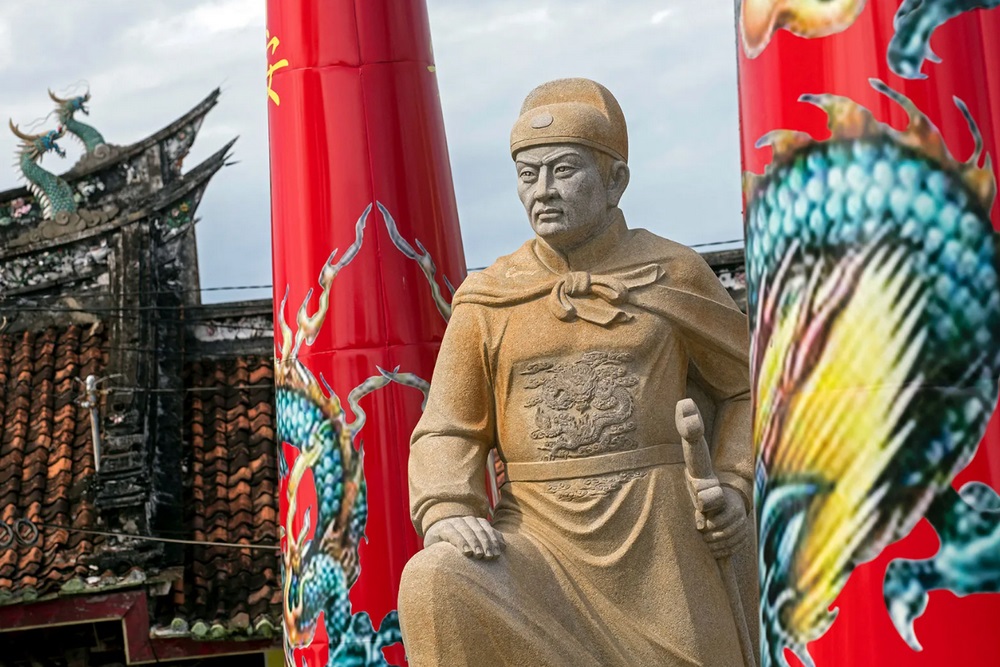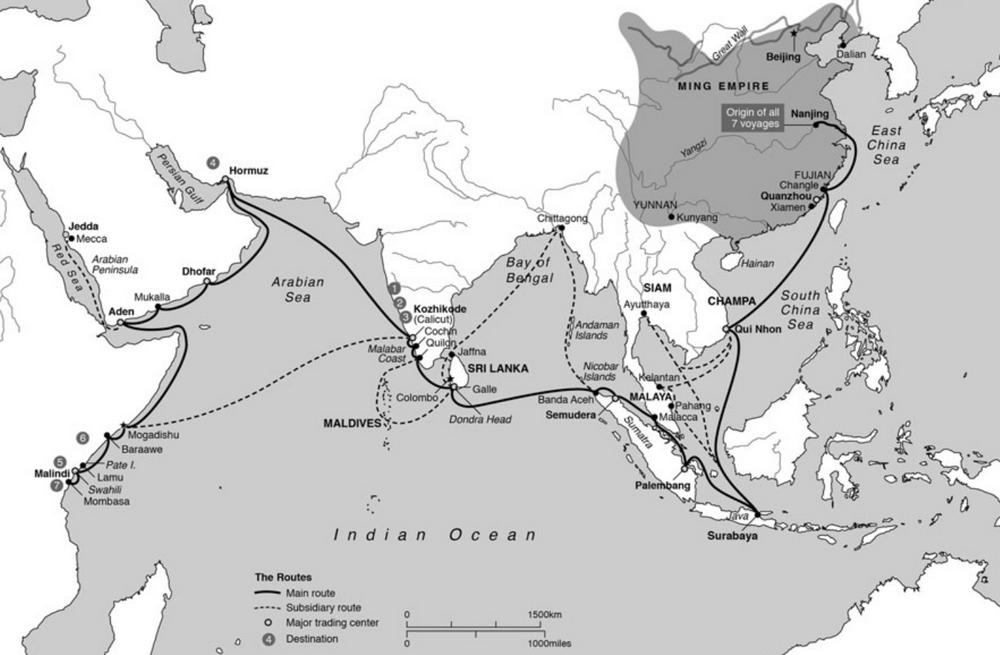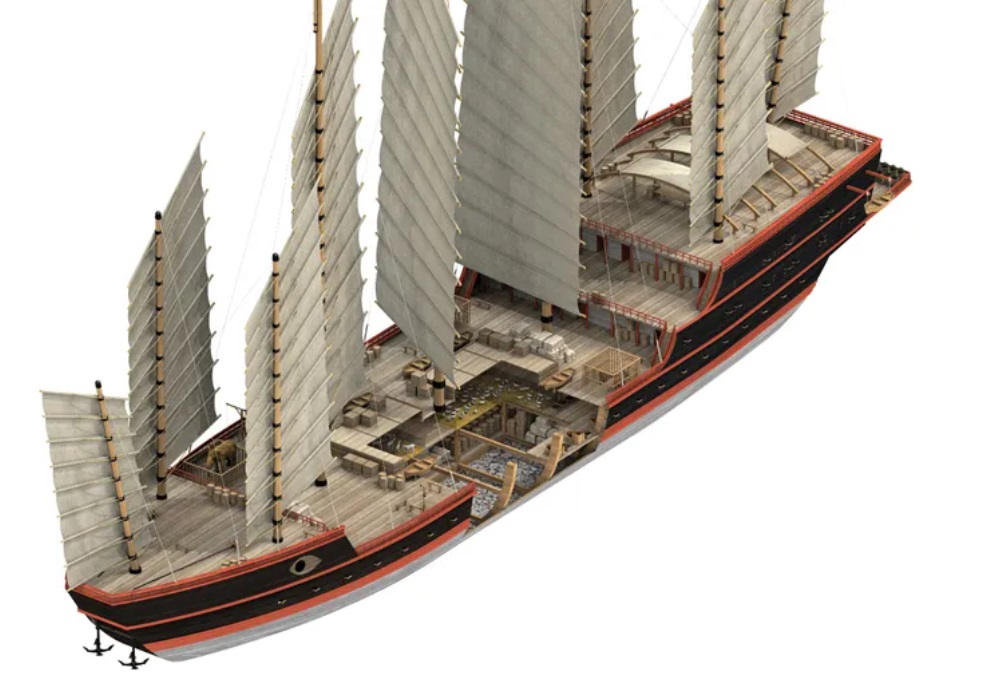
By Aldo Matteucci
Ever since Gavin Menzies, a British retired naval officer, published the fictional story 1421: The Year China Discovered America, fleet admiral and diplomat Zheng He (1371–1433) has enjoyed a sort of revival as the Chinese explorer who might have circumnavigated the Earth before the age of Western exploration. I don’t know whether this is true or not, so let’s skip this take on him.
This trope replaces the previous one that had cast Zheng He as the luckless admiral who might have led China in an effort to establish an overseas empire, were it not for the inward looking Confucian bureaucrats in Nanjing and Beijing, who closed China to the world.
In fairness to history, the third Ming emperor, Yongle (1402–1424), who selected Zheng He to be the commander in chief of what became a series of missions to the ‘Western Oceans’, was a man of action. He overextended the empire’s resources, and at the end of his reign, retrenchment became inevitable in face of the collapse of the paper-money system which had funded his many adventures, and those of Zheng He. The abandonment of the Indian Ocean reflects a more realistic view of China’s possibilities. Still, completing the Great Wall of China (which the Chinese actually called The Long Wall) is taken to be a symbol of the Ming dynasty’s inward looking attitude.
Trade monopoly: Europe vs Ancient China
Could China have profited from an overseas empire? We in the West see empire-building as such a self-evident policy that we don’t stop a minute and reflect on the fact that China and Europe were different. The first was a unified empire, the second a region of warring statelets.
1. If one is an European warring state keen on profit from international trade, the thing to do is to obtain an import monopoly in Europe, and the rest of Europe will have to pay the import prices set by the monopolist (revenues may be then invested (or wasted) in intra-European warring). To protect the monopoly position within Europe, one needs to protect the supply chain all the way up to the overseas producer. This is why the Dutch settled in Indonesia, and the British in Bengal. Competitive empire-building reflects the fragmented structure of warring Europe.
China on the other hand was a unified state. It was immaterial where the imports landed. In fact, an open trading system ensured China competitive prices. From all over the Indian Ocean and the Indonesian archipelago, traders, both foreign and Chinese, brought goods to China unbidden. Canton (Guangzhou) was a majority Muslim, reflecting their prominent role in the Indian Ocean. On the other hand, Chinese communities have taken on predominant roles along the coast of Indonesia.
2. Europe needed goods from the Orient. While China certainly appreciated goods from Indian Ocean trading, it needed foremost horses for its troops. That explains in part the fixation with the nomads to the north: it had a vital interest there and was ready to pay for it in silk. The Silk Road at the outset was a way for the nomadic Xiongnu to get rid, in India and the West, of surplus silk they’d gotten from the Han in exchange for horses under the tribute system. Its political roots lie in the realisation that neither side could win at war, and thus unilateral rent extraction through conquest respective pillage was not a viable policy.
Ever since the Song Empire (960–1279), China maintained a political presence in Southeast Asia, and a few political missions on squadrons had been sent into the region. Ming Emperor Yongle’s effort to send a fleet under Zheng He into the Indian Ocean has to be understood as a reinforcement and continuation of this policy. But was it necessary?
Zheng He’s fleet and voyages
Zheng He’s fleet of 250 ships, with 27,000 sailors and soldiers on board, sailed 7 times altogether into the Indian Ocean, visiting in turn Indonesia, Ceylon, Calicut, Hormuz, Aden, and Africa, all the way down to Malindi in present-day Kenya. It was an effort ‘to bring the Western Ocean into the Chinese tributary system by overawing, or if need be overpowering, opposition’ (from Edward L. Dreyer’s book Zheng He: China and the Oceans in the Early Ming Dynasty, 1405–1433). So they did, fighting in Ceylon, capturing pirates in Indonesia, and unseating a local pretender there. For the rest, they brought home goods – like the mythical qilin (giraffe) – and other ‘goods and treasures without name, which were too many to be accounted for, yet they did not make up for the wasteful expenses’, sneered the Confucian bureaucrats.

Ancient China and trade
And they were right, in a way: the terms of trade for horses were set at China’s northern door and the nomads paid the associated transport costs. Here, the exchange took place at the port of call, far away from China. The terms of trade reflected local conditions, and on top of that, China had to pay for transport costs. In economic terms, there was no way China could win. The Indian Ocean trading system brought goods to China – unbidden. A policy of dominance could increase the flow (at the risk of creating a supply overhang), but only by shouldering the collateral costs. And as a final point: silk textiles were being produced in India and the Middle East; what was in demand from China by then was tea and porcelain. Zheng He, as a good bureaucrat, may have missed the prevailing market conditions.
Ancient China’s tribute system
Most profoundly, China’s tribute system reflected a strategic choice: it represented a system of peaceful and commercial exchange in dealing with foreign powers – eschewing rent extraction through force. Given this choice, for all its ritual complexity, the tribute system was no more than a system of public procurement for vital goods (army horses from nomads in the north). There were no vital goods the Chinese state (or the Chinese court) saw the necessity to procure in the Indian Ocean.1 Consequently it applied a policy of benign (or malign2 at times) neglect.

How much did Zheng He’s explorations cost?
How much did all this cost? Building the fleet absorbed about half the tax receipts for one year, and then there was the expense of running the operation. A doable policy, but not a marginal expense, and therefore it was subjected to scrutiny as to its effectiveness. Showing the flag impressed everyone in sight, but politically they were all dwarfs. These places were duly impressed, went about the required motions of showing respect, and then settled back into their well-established routines as trade nodes. Even Calicut, or Hormuz, were just platforms of exchange, not of large scale production. In this light, retrenchment is understandable.
A unique, self-sufficient fleet
What about Zheng He? Zheng He was a genius in his own way, albeit unrecognised to this day. His skill was in the area of logistics and organisation, and here he still is unmatched.
To my knowledge, there has never been (nor is there today) a fleet able to ‘project power’ (an army of over 5,000 marines at the ready) in foreign waters repeatedly, for a period of up to 2 years each time (with a turn-around time of 4–6 months between missions). Along the way, the fleet was essentially self-sufficient, both as to supplies and to the upkeep of the ships. These were flat-bottomed wooden vessels with capital ships weighing around 20,000T each (opinions differ somewhat on this point), 4 times the largest ships of the Western line, lumbering at 2–3 knots of speed powered by 9 masts, and able to sail for 20–30 days out of sight of land. And though he may have lost the odd vessel, in the 30 years that the fleet was kept up, Zheng He never lost even a fraction of the fleet to storm.
What an engineering and organisational performance!
—
1. When Emperor Qianlong, who reigned 1735–1796, indicated to the British Envoy Macartney in 1793 that China did not need any British goods, he was using such a ‘public (or court) procurement’ lens. From such an angle, the statement was understandable.
2. Trade between China and Southeast Asia continued, disrupted at times by imperial edicts, and then followed by accommodation.
Source: DeepDip and DIPLO
Note: China was a vastly different place before 1949 when Chinese Community Party took control of the mainland China. The CCP destroyed most and all ancient china’s civilization, and abandoned traditional Chinese culture and moral disciplines throughout its ruling.









Cancel anytime


Using our website
You may use the The Middle Land website subject to the Terms and Conditions set out on this page. Visit this page regularly to check the latest Terms and Conditions. Access and use of this site constitutes your acceptance of the Terms and Conditions in-force at the time of use.
Intellectual property
Names, images and logos displayed on this site that identify The Middle Land are the intellectual property of New San Cai Inc. Copying any of this material is not permitted without prior written approval from the owner of the relevant intellectual property rights.
Requests for such approval should be directed to the competition committee.
Please provide details of your intended use of the relevant material and include your contact details including name, address, telephone number, fax number and email.
Linking policy
You do not have to ask permission to link directly to pages hosted on this website. However, we do not permit our pages to be loaded directly into frames on your website. Our pages must load into the user’s entire window.
The Middle Land is not responsible for the contents or reliability of any site to which it is hyperlinked and does not necessarily endorse the views expressed within them. Linking to or from this site should not be taken as endorsement of any kind. We cannot guarantee that these links will work all the time and have no control over the availability of the linked pages.
Submissions
All information, data, text, graphics or any other materials whatsoever uploaded or transmitted by you is your sole responsibility. This means that you are entirely responsible for all content you upload, post, email or otherwise transmit to the The Middle Land website.
Virus protection
We make every effort to check and test material at all stages of production. It is always recommended to run an anti-virus program on all material downloaded from the Internet. We cannot accept any responsibility for any loss, disruption or damage to your data or computer system, which may occur while using material derived from this website.
Disclaimer
The website is provided ‘as is’, without any representation or endorsement made, and without warranty of any kind whether express or implied.
Your use of any information or materials on this website is entirely at your own risk, for which we shall not be liable. It is your responsibility to ensure any products, services or information available through this website meet your specific requirements.
We do not warrant the operation of this site will be uninterrupted or error free, that defects will be corrected, or that this site or the server that makes it available are free of viruses or represent the full functionality, accuracy and reliability of the materials. In no event will we be liable for any loss or damage including, without limitation, loss of profits, indirect or consequential loss or damage, or any loss or damages whatsoever arising from the use, or loss of data, arising out of – or in connection with – the use of this website.
Last Updated: September 11, 2024
New San Cai Inc. (hereinafter “The Middle Land,” “we,” “us,” or “our”) owns and operates www.themiddleland.com, its affiliated websites and applications (our “Sites”), and provides related products, services, newsletters, and other offerings (together with the Sites, our “Services”) to art lovers and visitors around the world.
This Privacy Policy (the “Policy”) is intended to provide you with information on how we collect, use, and share your personal data. We process personal data from visitors of our Sites, users of our Services, readers or bloggers (collectively, “you” or “your”). Personal data is any information about you. This Policy also describes your choices regarding use, access, and correction of your personal information.
If after reading this Policy you have additional questions or would like further information, please email at middleland@protonmail.com.
PERSONAL DATA WE COLLECT AND HOW WE USE IT
We collect and process personal data only for lawful reasons, such as our legitimate business interests, your consent, or to fulfill our legal or contractual obligations.
Information You Provide to Us
Most of the information Join Talents collects is provided by you voluntarily while using our Services. We do not request highly sensitive data, such as health or medical information, racial or ethnic origin, political opinions, religious or philosophical beliefs, trade union membership, etc. and we ask that you refrain from sending us any such information.
Here are the types of personal data that you voluntarily provide to us:
As a registered users or customers, you may ask us to review or retrieve emails sent to your business. We will access these emails to provide these services for you.
We use the personal data you provide to us for the following business purposes:
Information Obtained from Third-Party Sources
We collect and publish biographical and other information about users, which we use to promote the articles and our bloggers who use our sites. If you provide personal information about others, or if others give us your information, we will only use that information for the specific reason for which it was provided.
Information We Collect by Automated Means
Log Files
The site uses your IP address to help diagnose server problems, and to administer our website. We use your IP addresses to analyze trends and gather broad demographic information for aggregate use.
Every time you access our Site, some data is temporarily stored and processed in a log file, such as your IP addresses, the browser types, the operating systems, the recalled page, or the date and time of the recall. This data is only evaluated for statistical purposes, such as to help us diagnose problems with our servers, to administer our sites, or to improve our Services.
Do Not Track
Your browser or device may include “Do Not Track” functionality. Our information collection and disclosure practices, and the choices that we provide to customers, will continue to operate as described in this Privacy Policy, whether or not a “Do Not Track” signal is received.
HOW WE SHARE YOUR INFORMATION
We may share your personal data with third parties only in the ways that are described in this Privacy Policy. We do not sell, rent, or lease your personal data to third parties, and We does not transfer your personal data to third parties for their direct marketing purposes.
We may share your personal data with third parties as follows:
There may be other instances where we share your personal data with third parties based on your consent.
HOW WE STORE AND SECURE YOUR INFORMATION
We retain your information for as long as your account is active or as needed to provide you Services. If you wish to cancel your account, please contact us middleland@protonmail.com. We will retain and use your personal data as necessary to comply with legal obligations, resolve disputes, and enforce our agreements.
All you and our data are stored in the server in the United States, we do not sales or transfer your personal data to the third party. All information you provide is stored on a secure server, and we generally accepted industry standards to protect the personal data we process both during transmission and once received.
YOUR RIGHTS/OPT OUT
You may correct, update, amend, delete/remove, or deactivate your account and personal data by making the change on your Blog on www.themiddleland.com or by emailing middleland@protonmail.com. We will respond to your request within a reasonable timeframe.
You may choose to stop receiving Join Talents newsletters or marketing emails at any time by following the unsubscribe instructions included in those communications, or you can email us at middleland@protonmail.com
LINKS TO OTHER WEBSITES
The Middle Land include links to other websites whose privacy practices may differ from that of ours. If you submit personal data to any of those sites, your information is governed by their privacy statements. We encourage you to carefully read the Privacy Policy of any website you visit.
NOTE TO PARENTS OR GUARDIANS
Our Services are not intended for use by children, and we do not knowingly or intentionally solicit data from or market to children under the age of 18. We reserve the right to delete the child’s information and the child’s registration on the Sites.
PRIVACY POLICY CHANGES
We may update this Privacy Policy to reflect changes to our personal data processing practices. If any material changes are made, we will notify you on the Sites prior to the change becoming effective. You are encouraged to periodically review this Policy.
HOW TO CONTACT US
If you have any questions about our Privacy Policy, please email middleland@protonmail.com
The Michelin brothers created the guide, which included information like maps, car mechanics listings, hotels and petrol stations across France to spur demand.
The guide began to award stars to fine dining restaurants in 1926.
At first, they offered just one star, the concept was expanded in 1931 to include one, two and three stars. One star establishments represent a “very good restaurant in its category”. Two honour “excellent cooking, worth a detour” and three reward “exceptional cuisine, worth a
Thank you for your participation,
please Log in or Sign up to Vote

123Sign in to your account